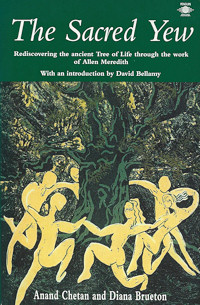
The Sacred Yew (Book)
by Anand Chetan and Diana Brueton
from the work of Allen Meredith 1994
'What magic is there in the ancient yew tree? What is it in them that fires our vision and fills the soul with mystery, touching ageless history?
We associate our yew trees with our churchyards. There we constantly find them gracing the church and spreading their great arms among the graves. And many people may tacitly assume that the 'old folk' planted yews in churchyards. But no! The great yew trees can be 2,000 years old , or 3,000 or, in some cases, they may reach 4,000 years or more and our churches were mostly built less than 1,000 years ago. The yews came first, planted on sacred sites known to the Druids. The later church builders were sensitive to the holy places and knew where to build their churches. So let us awaken to the wonder of the yews, planted long before the churches were built and linked with ancient pre-Christian ritual and mystery.
What a marvel is the ancient yew! It is claimed that the great yew could be absolutely immortal! Grasp what it is doing. The central complex of bole and trunk often seems like a number of trees flowing into each other to make an entity of incredible strength. Then the branches around the central trunk dip down and reroot themselves so that, as a virtually new tree, they may send out further branches. Thus theoretically at least, the process can go on till the ringed complex covers a great area.
Our imagination is fired by this tree. Once we have 'seen' a yew tree, then it becomes fascinating to study the complex bole and and see how the streams of energy flow along its ribs. Our imaginative vision can merge with the wondrous structure. Theoretically, the yew tree could be ageless and never die, the central trunk like a compact pillar of immense strength.
Alas that through ignorance and indifference many great trees in our churchyards have been destroyed as inconvenient. But they are sacred trees and it is vital that we recover this knowledge. Preserving the great yews is a duty that we owe to our forebears, to the history of our countryside and to those who come after us.' Sir George Trevelyan
'One tree had always stood out. Though used for long bows, the Yew's regenerative powers and the poisonous nature of its leaves and seeds denied its use for other things. So many were spared the axe and grew to gnarled old age - patriarchs of a fast disappearing forest, things of wonder, mystery and imagination. They became special meeting places where decisions were taken, secrets shared, a place of reverence and worship, for the sacred tree could kill or cure.'
David Bellamy, Naturalist
